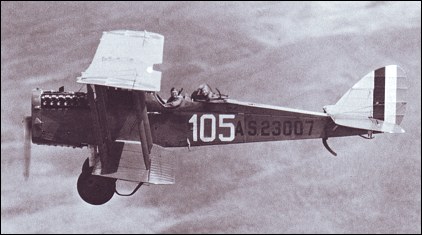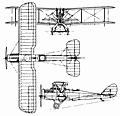 |
De Havilland (Airco) D.H.41916 |  |
| BOMBER | Virtual Aircraft Museum / United Kingdom / De Havilland |
 |
One of the most outstanding combat aircraft produced during World War I, the DH.4 day bomber was built in large numbers: 1449 aircraft in Britain and 4846 in the USA, where many were powered by the excellent 400hp Liberty 12 engine. The protoype DH.4 flew in August 1916, and pilots were unanimous in their praise of its fine handling qualities, wide speed range and a perfonnance which made it almost immune from interception. The first DH.4s arrived in France with No 55 Squadron in March 1917 and began operations against German targets in April. In addition to its primary bombing role, the aircraft was used for photo-reconnaissance, long-range fighter sweeps and antisubmarine patrols. The DH.4 was widely used by the Royal Naval Air Service (RNAS), and on 15 August 1918 an aircraft from RNAS Great Yarmouth, flown by Major Egbert Cadbury, shot down the Zeppelin L.70. After the war, many DH.4s were used in civilian roles, such as crop-dusting, mail carriage and aerial survey.
Greg Fey, e-mail, 28.10.2022  Aaron Weaver Aaron WeaverMy mistake, Lt Fey was transferred from Kelly Field Texas to Wheeler Field Hawaii in 1926. Luke Field was an airfield in Hawaii from 1917 to 1939, and there are plenty of photos online from the Air Service 11th photo section from that time period. Aaron Weavet, e-mail, 07.09.2022  Vintage1 Vintage1You are right! The Liberty Vee-12 engine used those huge two-bladed props. The various British versions utilizing the four bladed props were fitted with the Vee-12 engines by Rolls-Royce (Eagle VII and VIII), and the RAF 3a Vee 12. Aaron Weavet, e-mail, 07.09.2022  Vintage1 Vintage1You are right! The Liberty Vee-12 engine used those huge two-bladed props. The various British versions utilizing the four bladed props were fitted with the Vee-12 engines by Rolls-Royce (Eagle VII and VIII), and the RAF 3a Vee 12. Aaron Weavet, e-mail, 07.09.2022  Vintage1 Vintage1You are right! The Liberty Vee-12 engine used those huge two-bladed props. The various British versions utilizing the four bladed props were fitted with the Vee-12 engines by Rolls-Royce (Eagle VII and VIII), and the RAF 3a Vee 12. Aaron Weaver, e-mail, 07.09.2022  Robert Guttman Robert GuttmanThe DH-9a was a British aircraft and not built in the US. It also was not used by the US. The DH-9a was the result of poor performance of the DH-9 and the heavy losses being incurred because of the unreliable Siddeley Puma engine. There weren’t enough Rolls-Royce engines to go around due to heavy demand, but the availability of the 400 hp Liberty engine gave them a quick solution to address those reliability and performance problems. Redesigning the nose section to fit the new engine and frontal radiator were not a big hit to redevelopment timeline. Aaron Weaver, e-mail, 07.09.2022  Robert Guttman Robert GuttmanThe DH-9a was a British aircraft and not built in the US. It also was not used by the US. The DH-9a was the result of poor performance of the DH-9 and the heavy losses being incurred because of the unreliable Siddeley Puma engine. There weren’t enough Rolls-Royce engines to go around due to heavy demand, but the availability of the 400 hp Liberty engine gave them a quick solution to address those reliability and performance problems. Redesigning the nose section to fit the new engine and frontal radiator were not a big hit to redevelopment timeline. Aaron Weaver, e-mail, 07.09.2022  Tom Fattorini Tom FattoriniThe logbook entry for 24 Aug 1917 is describing a license-built aircraft that was fitted with the 200 hp RAF 3 Vee-12 engine. These utilized a four-bladed propeller and the propeller shaft had a higher thrust line, possibly due to a reduction gear. There were several companies producing variants under license and fitted with various engines that were available, Rolls-Royce, BHP, FIAT, RAF, Siddely-Deasy, Beardmore, Sunbeam, etc. which differed somewhat in appearance ie. engine, radiator, and fuselage details depending on the manufacturer. Aaron Weaver, e-mail, 07.09.2022  Tom Fattorini Tom FattoriniThe logbook entry for 24 Aug 1917 is describing a license-built aircraft that was fitted with the 200 hp RAF 3 Vee-12 engine. These utilized a four-bladed propeller and the propeller shaft had a higher thrust line, possibly due to a reduction gear. There were several companies producing variants under license and fitted with various engines that were available, Rolls-Royce, BHP, FIAT, RAF, Siddely-Deasy, Beardmore, Sunbeam, etc. which differed somewhat in appearance ie. engine, radiator, and fuselage details depending on the manufacturer. Aaron Weaver, e-mail, 07.09.2022  Pete Arundel Pete ArundelOnly one problem… I don’t think the DH-9a, other than being a British aircraft using an American engine, was ever built or used by the USA either during the war or after. They also wouldn’t have been shipped here postwar when they were being dismantled and burned or scrapped en masse to avoid the expense of shipping them home. It was a standard RAF type in the postwar years all over the Empire. The aircraft is a postwar DH-4B that changed the location of the pilot cockpit with the fuel tank aka DH-9. That was a design change probably requested in the postwar contracts with Boeing and whoever else had contracts to build them. Peter Arundel, e-mail, 07.09.2022  Aaron Weaver Aaron WeaverYou see what we have here is a classic case of "just what defines a . . ."
|  COMPANY PROFILE | ||||||||||||||||||||||||||||||||||||||||||||||||
 |

|


Kelly Field is in Texas. Luke Field, I believe, is in Arizona since that is where Frank Luke, it’s namesake is from.
reply